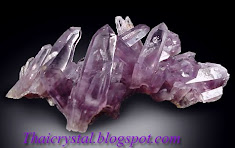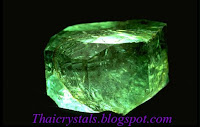Any solid material whose atoms are arranged in a definite pattern and whose surface regularity reflects its internal symmetry. Each of a crystal's millions of individual structural units (unit cells) contains all the substance's atoms, molecules, or ions in the same proportions as in its chemical formula (see formula weight). The cells are repeated in all directions to form a geometric pattern, manifested by the number and orientation of external planes (crystal faces). Crystals are classified into seven crystallographic systems based on their symmetry: isometric, trigonal, hexagonal, tetragonal, orthorhombic, monoclinic, and triclinic. Crystals are generally formed when a liquid solidifies, a vapour becomes supersaturated (see saturation), or a liquid solution can no longer retain dissolved material, which is then precipitated. Metals, alloys, minerals, and semiconductors are all crystalline, at least microscopically. (A noncrystalline solid is called amorphous.) Under special conditions, a single crystal can grow to a substantial size; examples include gemstones and some artificial crystals. Few crystals are perfect; defects affect the material's electrical behaviour and may weaken or strengthen it.
A solid in which the atoms or molecules are arranged periodically. Within a crystal, many identical parallelepiped unit cells, each containing a group of atoms, are packed together to fill all space (see illustration). In scientific nomenclature, the term crystal is usually short for single crystal, a single periodic arrangement of atoms. Most gems are single crystals. However, many materials are polycrystalline, consisting of many small grains, each of which is a single crystal. For example, most metals are polycrystalline
Structure of a simple crystal. Spheres, representing atoms, are packed together into a cubic lattice. This crystal has 4-fold symmetry axes passing through the front face; after a 90° rotation the structure appears unchanged
In electronics, the term crystal is restricted to mean piezoelectric crystal. Piezoelectric crystals contract or expand under application of electric voltages, and conversely they generate voltages when compressed. They are used for oscillators, pressure sensors, and position actuators.
The anisotropic microscopic structure of a crystal is often reflected in its external form, consisting of flat faces and sharp edges. Crystal structure is generally determined via diffraction of x-rays, neutrons, or electrons. Unlike disordered materials such as glasses or liquids, the diffraction pattern of a periodic array of atoms consists of individual sharp spots. The symmetry and structure of the crystal can be inferred from the symmetry of the diffraction pattern and the intensities of the diffracted beams.
A crystal can be characterized by the symmetry operations that leave its structure invariant. These can include rotation about an axis through a specific angle, reflection through a plane, inversion through a point, translations by a unit cell dimension, and combinations of these. For a periodic structure, the only allowable rotational symmetries are 2-fold, 3-fold, 4-fold, and 6-fold. A quasicrystal is a solid which yields a sharp diffraction pattern but has rotational symmetries (such as 5-fold or 10-fold) which are inconsistent with a periodic arrangement of atoms.
A plastic crystal is generally composed of organic molecules which are rotationally disordered. The centers of the molecules lie at well-defined, periodically spaced positions, but the orientations of the molecules are random. Plastic crystals are often very soft and may flow under their own weight.
A liquid crystal is a material which is intermediate in structure between a liquid and a solid. Liquid crystals usually flow like liquids but have some degree of internal order. They are generally composed of rodlike organic molecules, although in some cases they are composed of disklike molecules. In a nematic liquid crystal, the rods all have the same general orientation, but the positions of the rods are disordered. In a smectic liquid crystal, rodlike molecules are ordered into sheets, within which there is only liquidlike order. A smectic can thus be thought of as being crystalline in one dimension and liquid in the other two. In a discotic liquid crystal, disklike molecules are ordered into columnar arrays; there is short-range liquidlike order within the columns, but the columns form a two-dimensional crystal.



















































